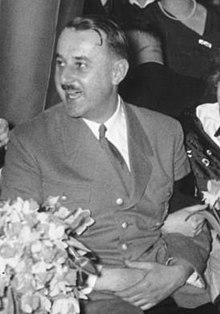
Back هيرمان إيسر Arabic هيرمان ايسر ARZ Херман Есер Bulgarian Hermann Esser Czech Hermann Esser German Hermann Esser Spanish Hermann Esser Finnish Hermann Esser French Hermann Esser ID Hermann Esser Italian
Hermann Esser | |
|---|---|
 | |
| Second Vice President of the Reichstag, later Deputy to the Reichstag President | |
| In office 12 December 1933 – 8 May 1945 | |
| Preceded by | Walther Graef |
| Succeeded by | Position abolished |
| State Secretary for Tourism Reich Ministry of Public Enlightenment and Propaganda | |
| In office 4 March 1939 – 8 May 1945 | |
| Bavarian Minister of Economics | |
| In office 1 March 1934 – 21 March 1935 | |
| Preceded by | Ludwig Siebert |
| Succeeded by | Hans Dauser |
| Gauleiter Upper Bavaria-Swabia | |
| In office 16 September 1926 – May 1927 | |
| Preceded by | Position established |
| Succeeded by | Fritz Reinhardt |
| Reichspropagandaleiter | |
| In office 4 August 1925 – April 1926 | |
| Preceded by | Otto May |
| Succeeded by | Gregor Strasser |
| Personal details | |
| Born | 29 July 1900 Röhrmoos, Kingdom of Bavaria, German Empire |
| Died | 7 February 1981 (aged 80) Dietramszell, Bavaria, West Germany |
| Political party | Nazi Party |
| Military service | |
| Allegiance | |
| Branch/service | |
| Years of service | 1917–1918 |
| Battles/wars | World War I |
Hermann Esser (29 July 1900 – 7 February 1981) was an early member of the Nazi Party (NSDAP). A journalist, Esser was the editor of the Nazi paper, Völkischer Beobachter, a Propaganda Leader, and a Vice President of the Reichstag. In the early days of the party, he was a de facto deputy of Adolf Hitler. As one of Hitler's earliest followers and friends, he held influential positions in the party during the Weimar Republic, but increasingly lost influence during the Nazi era.